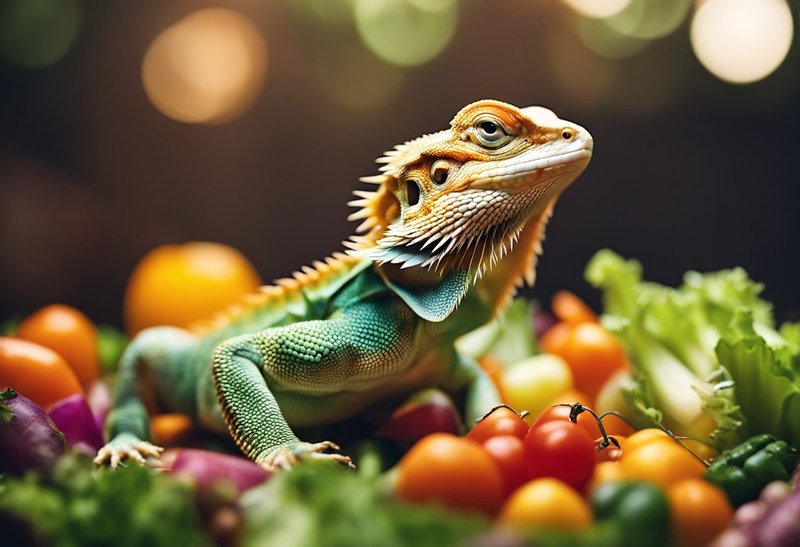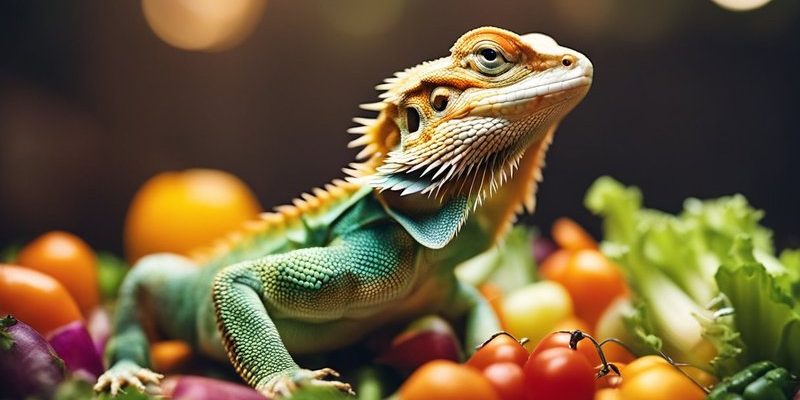
You might be wondering, “What do bearded dragons actually eat?” Well, they have a varied menu that includes insects, vegetables, and even some supplements. Let’s dive into each category so you can get a clearer picture of your dragon’s dining needs. Think of it like putting together a nutritious meal plan for a family member—with the right mix of flavors and nutrients, your bearded buddy can live a happy, healthy life!
The Role of Insects in a Bearded Dragon’s Diet
Insects are like the main course for bearded dragons, packed with protein and essential nutrients. Think of them as the chicken or beef for your lizard pal. Depending on their age, your beardie will need to munch on different types of insects to support their growth and energy levels.
Common Insects to Feed:
- Crickets
- Mealworms
- Dubia roaches
- Superworms
Crickets are a favorite because they’re easy to find at pet stores and provide good protein. Mealworms are another option, but they should be given sparingly since they’re higher in fat. Dubia roaches are becoming popular too—they’re nutritious and don’t smell as bad as crickets! Just remember that the size of the insect should be appropriate for the size of your dragon—think of it as cooking a meal that suits the palate of your guest!
The Right Amount of Insects
How many insects should you provide? As a rule of thumb, young bearded dragons (hatchlings to about 6 months) need more protein, so aim for 20-50 insects a day. That might sound like a lot, but those little critters are small! As your bearded dragon matures (around 6 months and older), you can cut back to around 10-20 insects a day. You might find it helpful to have a feeding schedule to keep track, just like you would for a toddler!
Vegetables: The Colorful Side Dish
Just like any well-balanced meal, vegetables play a vital role in a bearded dragon’s diet. Think of veggies as the salad portion—necessary for health but not the main attraction. They provide essential vitamins and minerals that help with digestion and overall health.
Best Veggies for Bearded Dragons:
- Collard greens
- Mustard greens
- Bell peppers
- Squash
- Carrots
When you offer vegetables, you’re providing your bearded dragon with a tasty way to stay hydrated and healthy. These leafy greens are rich in calcium and vitamins A and C. Just chop them into bite-sized pieces, almost like prepping a veggie platter.
How to Prepare Veggies
Preparation is key! Make sure to wash all veggies thoroughly to remove any pesticides. You can serve the veggies raw or steamed—steaming can soften them up a bit, making it easier for your beardie to munch. Just remember not to overdo it on starchy veggies like corn or peas; they should only be an occasional treat.
The Importance of Supplements
Now, let’s chat about supplements. It might sound a bit technical, but think of them as the vitamins you take to stay healthy. Sometimes, even the best diets can miss a few nutrients, and this is where supplements step in.
Common Supplements for Bearded Dragons:
- Calcium powder
- Vitamin D3
- Multivitamins
Calcium powder is crucial for bone health, especially for young and growing dragons. If they don’t get enough calcium, they might develop metabolic bone disease, which is serious. Dust their insects with calcium powder a few times a week, and sprinkle some multivitamins every other week. Just like we need a balanced diet with a splash of supplements, your bearded dragon benefits from a similar approach.
When to Use Supplements
Timing matters! You should ideally use supplements during the active feeding period when your bearded dragon is most likely to eat. If you’re unsure how much to use, it’s a good idea to consult your vet—they can give you the best advice based on your dragon’s specific needs.
Hydration: Don’t Forget the Water!
Here’s something often overlooked: hydration! Just because bearded dragons are reptiles doesn’t mean they don’t need water. They can actually absorb moisture through their skin, but they also drink from dishes.
How to Provide Water:
- Shallow water dish
- Regular misting
- Soaking (occasionally)
Place a shallow dish in their enclosure, and make sure to change the water daily. Some people even mist their beardies lightly to encourage drinking. Every once in a while, giving your dragon a quick soak in lukewarm water can aid in hydration. Just always supervise to make sure they’re safe!
Signs of Dehydration
You might notice signs of dehydration like sunken eyes or lethargy. If you see these signs, it’s crucial to act quickly—provide water and perhaps consult a vet if things don’t improve. Keeping your bearded dragon hydrated is just as important as their food!
Avoiding Toxic Foods
While it’s fun to explore all the foods your beardie can munch on, it’s just as crucial to know what they can’t eat. Some foods can be toxic or harmful to your pet, and knowing these can save you from potential problems down the line.
Foods to Avoid:
- Avocado
- Rhubarb
- Onions
- Garlic
- Iceberg lettuce
These foods can lead to serious health issues if consumed. It’s best to keep these out of reach completely. Always check before introducing a new food, and when in doubt, consult with your vet.
How to Introduce New Foods
If you want to try new foods, do it gradually. Introduce one new item at a time and monitor your beardie for any reactions. It’s a little like trying a new dish at a restaurant—you want to make sure you enjoy it before you order it again!
Feeding your bearded dragon might seem complicated at first, but it’s all about balance. With a mix of insects, veggies, and the right supplements, your little friend can thrive. Remember to keep an eye on hydration and avoid toxic foods, and you’ll be well on your way to being a great bearded dragon owner. Think of it as a fun culinary adventure, where you’re the chef responsible for your dragon’s health.
With this knowledge, you can ensure your bearded dragon stays happy and healthy. Just remember, every dragon is unique—so pay attention to what works best for yours. Happy feeding!

